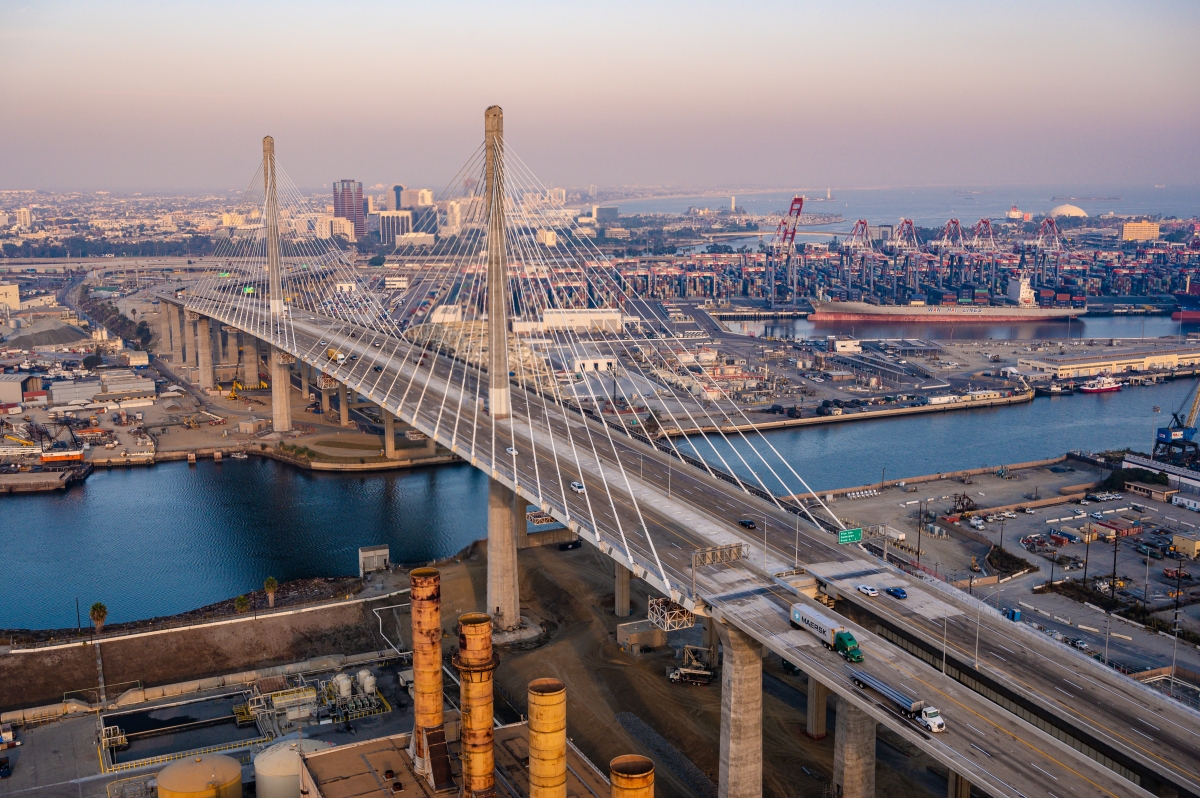2021 WTS-LA Innovative Transportation Solutions Award: Long Beach International Gateway (Gerald Desmond Bridge Replacement Project)
A Bridge to Star: How Women Helped Bridge the Global Supply Chain
Necessity is deemed to be the mother of invention. And that’s accurate. Throughout time women have contributed equally and mightily, though not necessarily with credit, to invention of every kind in every discipline. Transportation is no exception. And each year, WTS-LA recognizes a project—largely driven and/or conceived by women—that demonstrates such timeless innovation. The $1.47 billion Gerald Desmond Bridge Replacement Project—now named the Long Beach International Gateway Bridge—perfectly embodies what the 2021 WTS-LA Innovative Transportation Solutions Award is all about.
It was essential. Connecting the Port of Long Beach (POLB) to the 710 Freeway and therefore rest of the nation, the Gerald Desmond Bridge is of international strategic importance. But there was a problem. It was old and declared functionally obsolete. Completed in 1968, the Gerald Desmond Bridge was simply not designed to carry today’s modern, voluminous traffic loads. In addition, it had serious roadway deficiencies, including a lack of shoulders and poor grading that contributed to severe congestion, increased travel times, and higher emissions for the abundant number of heavy-duty trucks and passenger cars that used the bridge every day. Not being able to handle anticipated future traffic growth created even greater jeopardy for the bridge and its users. Enter the Gerald Desmond Bridge Replacement Project.
The newly named Long Beach International Gateway Bridge incorporated numerous innovative concepts. A cable-stayed design—a first for a vehicular bridge in California—its main span alone stretches for approximately 2,000 feet, with the towers connecting the cables to the road deck soaring 515 feet above the harbor. That makes for quite a striking image in an already dramatic setting. But aside from its stark beauty, the new bridge’s design has a very real, functional purpose. It raises clearance of POLB’s Back Channel from 155 feet to 205 feet, allowing larger cargo ships to safely access the port’s inner harbor terminals. With three lanes in each direction and safety shoulders, the new bridge is wider and better able to serve nearly 70,000 vehicles per day with additional capacity to handle the expected 125,000 vehicles per day by 2030. The bridge also sports a separated bicycle-pedestrian path enhanced by three scenic overlooks. That is all obvious from a good look at the bridge. But what many may never see is that a multitude of women played significant roles in leading, financing, administering, planning, designing, and building the new bridge. How significant?
Consider the following. POLB Chief Harbor Engineer Suzanne Plezia—POLB’s first female Chief Harbor Engineer—served as the “architect” of the design-build delivery team that realized the successful completion of the project from start to finish. POLB Director of Survey Kim Holtz created essential right-of-way maps, developed legal descriptions, compiled Record of Surveys, and supported the transfer of the property to Caltrans—a complex process to officially hand over the bridge as part of the state highway program. Former POLB Transportation Planning Director Allison Yoh coordinated extensively with Caltrans regarding easements, property transfer, and operations agreements. POLB Transportation and Master Planning Director Theresa Dau-Ngo led a multi-jurisdictional “Port Area Traffic Management” effort to safely maintain traffic flow and cargo movement during bridge construction. POLB Planning and Environmental Affairs Managing Director Heather Tomley handled overall management of the EIR/EA and oversaw solicitations for the Mitigation Grant Program. And POLB CEQA/NEPA Manager Allyson Teramoto managed the project’s Mitigation Monitoring and Reporting Program, while also tracking mitigation measures to ensure compliance with the EIR/EA. And that’s just from the POLB side.
Women from Caltrans—including former District 7 Director Carrie Bowen, former Deputy Director Shirley Choate, current Deputy Director Gloria Roberts, and Deputy Project Director Hanna Dergham —along with numerous female consultants and contractors helped make this essential piece of strategic infrastructure a dazzling reality. The significance of their contribution is tremendous. An estimated 15 percent of the nation’s inbound waterborne cargo travels over that bridge, helping to empower the nation’s largest port complex. For that reason alone, the project deserves considerable recognition. Because of its outstanding innovation and contribution from women, WTS-LA proudly names it the 2021 WTS-LA Innovative Transportation Solutions Award winner.
